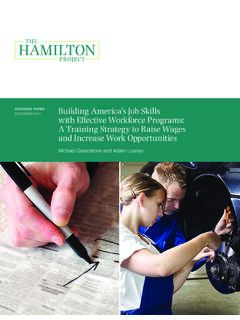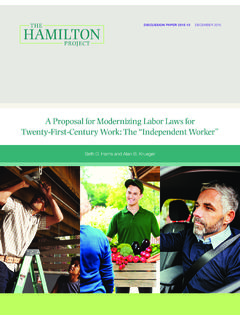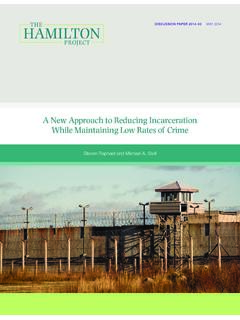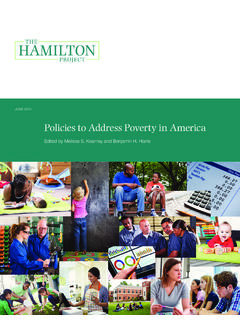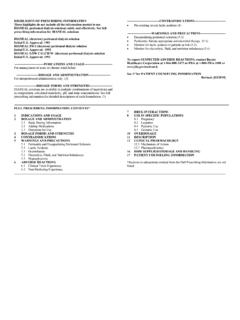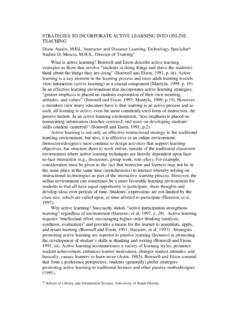Transcription of If You Build It: A Guide to the Economics of ...
1 Advancing Opportunity, Prosperity, and Growth W W W . H A M I LT O N P R O J E C T. O R G. If You Build It: A Guide to the Economics of Infrastructure investment By Diane Whitmore Schanzenbach, Ryan Nunn, and Greg Nantz FEBRUARY 2017. A founding principle of The Hamilton Project's economic strategy is that long-term prosperity is best achieved by fostering economic growth and broad participation in that growth. In that spirit, this paper seeks to provide an economic framework for evaluating infrastructure investments and their methods of funding and finance.
2 Why should we invest in infrastructure, what projects should be selected, who should decide, and how should those investments be paid for are all questions that can be better answered with the help of sound economic theory and evidence. In recent years American infrastructure investment has been insufficient to meet maintenance and expansion needs. By one important measure, annual investment has declined: net public non-defense investment at all levels of government was percent of GDP in 1980 and only percent in 2015 (Bureau of economic Analysis 2016).
3 As net investment has declined, the average age of infrastructure continues to increase, requiring additional spending just to keep up with deterioration and to meet safety standards. For example, pipes laid for water systems dating to the late 1800s, 1920s, and post-War era have life expectancies of about 120, 100, and 75 years respectively; by one estimate, the average utility will have to spend three-and-a-half times as much on pipe replacement in 2030 as it did 30 years earlier (American Water Works Association 2001). To some extent, infrastructure aging reflects deferred maintenance that must eventually be addressed so that infrastructure will continue to function properly, facilitating economic growth.
4 The American Society of Civil Engineers (2013) estimates that $ trillion would be required just to bring infrastructure into a state of good repair, not counting any expansion to the stock of Because much of the nation's infrastructure generates broadly shared benefits that are not limited to those who can pay, decisions about this infrastructure are an important public policy concern and not just a matter for private firms and investors. Of course, deciding precisely which infrastructure investments should be undertaken by the public sector is an important policy question that can be informed by careful analysis.
5 Having determined that particular infrastructure projects are worthwhile, it is also important to consider how the projects should be financed. With a number of approaches currently under discussion, including conventional debt finance and public-private partnerships (PPPs), deciding among the alternatives requires a clear exposition of their advantages and disadvantages. The Hamilton Project Brookings 1. Why Should We Invest in At the same time interest rates are relatively low, and as a result the interest cost of financing infrastructure investment is low.
6 Infrastructure? Figure 3 shows the long-run decline in 10-year Treasury note yields, a commonly referenced benchmark interest rate. With PRODUCTIVITY GROWTH HAS DIMINISHED AND. INTEREST RATES HAVE FALLEN. In the long run, improvements in standards of living are BOX 1. achieved through productivity growth (Gordon 2016). As we learn to make more-effective use of labor and capital, the What factors determine the economic economy becomes more productive: we produce more with returns to spending on infrastructure? less. Unfortunately, the United States has experienced a large slowdown in productivity growth over the past dozen years (see One way to approach infrastructure spending decisions figure 1) that amounts to about $ trillion of cumulative is in terms of how they affect economic activity, both lost economic output (Byrne, Fernald, and Reinsdorf 2016; locally , by increasing a port's capacity to move goods, or by reducing traffic congestion and nationally , Syverson 2016).
7 This slowdown has reduced growth in by stimulating demand for new parts built elsewhere. Americans' living standards, increased the difficulty of alleviating poverty, and might have even weakened institutions The following variables determine the returns to that support democracy (Friedman 2006). infrastructure spending: The magnitude of the economic returns to successful Although a number of tax, labor market, housing market, and projects other growth-relevant institutions could be playing a role in holding back innovation and productivity growth, substandard The share of infrastructure spending that goes to less infrastructure could also be an important contributor.
8 As productive projects for example, projects that are infrastructure deteriorates, many sectors of the economy lose selected for political rather than economic reasons their ability to operate efficiently. With fewer resources devoted The rate at which new infrastructure will depreciate to infrastructure projects that will enhance future output, growth The share of spending that simply replaces in productivity slows. Given its importance to economic growth, previously planned infrastructure investments by it is striking that public investment has slowed considerably over state and local governments time; figure 2 shows that public non-defense net investment fell The federal government's interest rate on borrowing by more than 50 percent from 2002 to 2015.
9 The stimulus effects on the economy, if applicable FIGURE 1. Change in Labor Productivity, 1980 2015. 5. Percent change from prior year 4. 3. 2. 1. 0. 1980 1985 1990 1995 2000 2005 2010 2015. Source: Bureau of Labor Statistics 2016; authors' calculations. Note: Values are shown as a trailing, five-year moving average. 2 If You Build It: A Guide to the Economics of Infrastructure investment this low cost of borrowing, capital-intensive investment of all INFRASTRUCTURE DEFICITS HAVE BECOME. kinds becomes more appealing to both the public and private LARGE.
10 Sectors, all other things being equal. Infrastructure investments Indeed, the potential for infrastructure improvements to enhance that once appeared to be cost-prohibitive can now be justified long-run growth appears to be substantial. Pervasive deficits economically, as explained in box 2, and could help reverse the in the quality of infrastructure have been widely documented downward trend in productivity growth. ( Department of Transportation 2016a; Environmental Protection Agency 2013). Figure 4 breaks out investment needs FIGURE 2.


